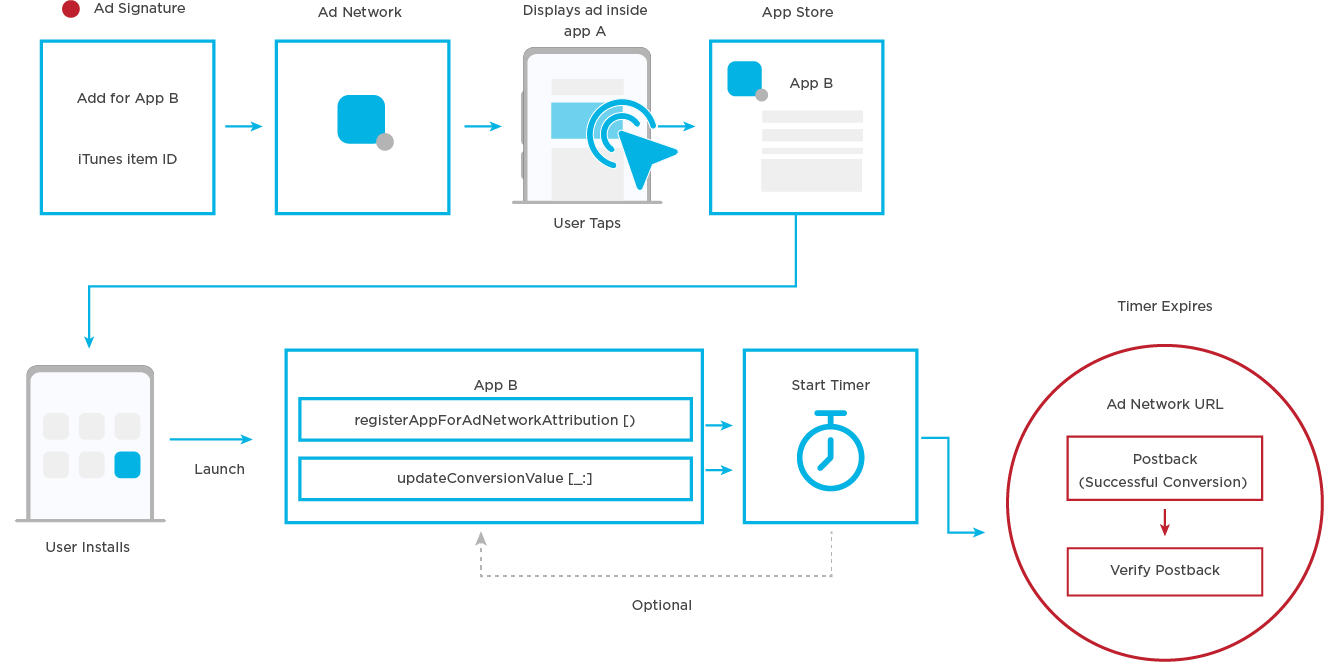Drive success within Apple’s digital iOS ecosystem as SKAN 4.0 approaches
User privacy and attribution: A delicate balance
In 2021, Apple turned the concept of mobile attribution for iOS on its head by releasing the App Tracking Transparency (ATT) framework with iOS 14.5. Before the ATT framework, publishers were not required to obtain app-level consent from users to request the identifier for advertisers (IDFA) and perform certain advertising tracking.
Pre iOS 14, iOS users could block access to their IDFA with the Limit Ad Tracking (LAT) feature within an iOS device’s settings menu. Other forms of non-deterministic advertising measurement were available when LAT was on. However, after iOS 14.5, any app that collects and shares user data with third parties is required to request user consent via the ATT framework. Essentially, the privacy feature gave control back to users by automatically opting iOS devices out of ad tracking by default. The impact of this shift is what catapulted Apple’s SKAdNetwork into the spotlight.
What is SKAdNetwork?
SKAdNetwork is Apple’s application programming interface (API) that offers a privacy-first approach to campaign measurement and attribution. In simple terms, SKAdnetwork is a storekit capability that helps advertisers determine their ad campaigns’ efficacy while increasing the privacy of iOS users. With SKAdNetwork, no user or device-level data is available, and all reporting is aggregated, anonymous, and delayed by design.

In the next section, we’ll unpack the most common terms associated with SKAdNetwork over the past couple of years. Before we get there, though, let’s touch on some recent additions.
SKAN v4.0 Updates from WWDC 2022
At WWDC 2022, Apple announced multiple updates for the fourth generation (v4.0) of SKAdNetwork. Here’s a breakdown of the big changes with some of the new related terminology:
Hierarchical IDs
There are progressively available values based on Apple’s privacy thresholds.
Crowd Anonymity Tiers
To date, Apple has not provided much detail around the privacy threshold that dictates the minimum attributed conversion volume, which must be before conversion values will be included in postbacks. With SKAN 4.0, Apple has finally defined three tiers of “crowd anonymity” based on attribution volume: low, medium, and high. With each tier, more granular data becomes available within the postback. Note that Apple still does not provide precisely what the tier thresholds are — only that with more attributed volume, each tier is reached.
Source Identifier
SKAN 4.0 replaces the 2-digit campaign identifier field from the ad impression with a new 4-digit ‘source identifier’ field. This field should be thought of as a ‘conversion value’ equivalent for the ad impression. Each of the 4 digits becomes available as higher tiers of crowd anonymity are reached. Similar to conversion values, these 4 digits could be used to represent different data. However, unlike conversion values, Apple obfuscates certain digits based on the level of crowd anonymity, which means each digit should represent something meaningful and discernable independently. Apple used the following model as an example:
- Digit #4 = Ad placement bucket
- Digit #3 = Date bucket
- Digit #1,2 = Campaign ID
As you can see, like conversion values, models could be defined to interpret each digit differently per customer based on needs.
Coarse Value
SKAN 4.0 introduces a new value which is set along with the conversion value in the advertiser app named the ‘coarse value.’ This coarse value can be set to one of three possible values (we’ll use “a”,”b”, and “c” in this blog) and is included in postbacks in place of the conversion value when the crowd anonymity tier restricts the conversion value. In other words, when the attribution volume is too low to allow the conversion value to be shared, the coarse value will be included in its place. Note that the coarse value and conversion value are mutually exclusive; the coarse value cannot be used in tandem with the conversion value in the conversion model.
Multiple conversions
SKAdNetwork has been limited to just one conversion postback. As of SKAN 4.0, up to 3 postbacks will be available. These postbacks are bucketed by the time of conversion, with the time ranges being between 0-2 days, 3-7 days, and 8-35 days. The last reported conversion to take place within a given time bucket is sent at the end of the window. It’s important to note that the conversion value will ONLY be available within the postback for the 0-2 days. Apple intends for the 3-7 and 8-35 day windows to be leveraged for reengagement.
Web-to-app attribution
This significant addition will fill the attribution gap SKAdNetwork had left for web-based campaign channels. To date, SKAdNetwork had only supported attribution for in-app campaigns where the user journey was app-to-app. With SKAN v4.0, Apple is adding support for URL link-based attribution.
Read the full summary for WWDC 2022 here.
Now, let’s look at some of the standard terms and concepts you’ll come across.
Other SKAdNetwork-related terms
App Tracking Transparency (ATT)
The AppTrackingTransparency (ATT) framework is Apple’s IDFA opt-in mechanism introduced with iOS 14. This mechanism requests user authorization to access app-related data. Permission must be granted to track the device. No user opt-in is required to use the SKAdNetwork since it’s anonymous and privacy-first by design.
Ad Network
An ad network is a platform that connects advertisers with publishers. Ad networks must register with Apple to operate over the SKAdNetwork. See all partners in the Kochava SKAdNetwork Certified Partner Program.
Source apps
This term refers to the apps that display campaign ads that are signed by an ad network for install validation with SKAdNetwork.
Advertised apps
This term refers to the app being advertised that is the target for user conversion.
App ID
The identifier is assigned to the advertised app where the user conversion takes place.
Source App ID
The identifier is assigned to the app where the ad impression is served and signed to the SKAdNetwork.
Fidelity Type
Dictates whether the ad interaction was an impression or click. Clicks are prioritized for attribution, as they show higher user intent than an impression.
Conversion Value
The conversion value is a method for reporting post-install engagements from the advertised app. The value can be any number between 0-63.
With SKAN v4.0, conversion values will become more hierarchical to provide either “coarse-grained” or “fine-grained” values based on the crowd anonymity tier achieved.
- The coarse value can be set to one of three possible values and is included in postbacks in place of the conversion value when the crowd anonymity tier restricts the conversion value.
- The fine value can be one of the 64 possible values (0-63) that we’re accustomed to today. It is only available when an adequate volume of installations has occurred.
Blank conversion values have been a pain point to date with SKAdNetwork. Adding the coarse value option means that some directional performance indicators will still be present when the fine conversion value can’t be shared yet.
Conversion Model
A conversion model enables marketers to pack more insight and meaning into the SKAdNetwork Conversion Value. The model utilizes a bit protocol framework that offers such insights as; the count of days since the install, highest value in-app action, list of events completed by the user, range of generated revenue, and the number of times a user completed an in-app action.
Kochava offers four configurable conversion models while also allowing advertisers to choose to build their own custom models. The four turnkey models include:
- Highest value event: User performance can be viewed based on the highest-value event completed by the user within the measurement window.
- Revenue: User performance can be viewed based on the user-generated revenue within the measurement window.
- User journey: User performance can be viewed based on a list of events completed by the user, regardless of order, within the measurement window.
- Engagement: User performance can be viewed based on the number of times the user completed a specific event within the measurement window.
Measurement window
The length of time an advertiser or their mobile measurement partner (MMP) allowed for conversion value updates to be called after app install. The longer the window, the further out the final postback would be delayed. With the updates coming to SKAN v4.0 and the Apple-defined time windows, the concept of the measurement window will change or be eliminated.
Timers
As part of SKAdNetwork’s data obfuscation mechanisms, two (2) timers were responsible for coordinating when the final install validation postback was fired. The first-timer was a static 24 hours and initiated once the app installation had occurred. The timer would begin a countdown and then reset any time a conversion value update was sent that featured a value higher than the last reported value. Once this timer expired, a second, randomized timer of 1-24 hours would commence. Once the second timer expired, the postback would be sent.
With the multiple conversion postbacks and windowed time range updates coming to SKAN v4.0, these timers will likely go away.
Stay up to date
As updates continue to roll out, marketers should strive to keep pace with SKAdNetwork if they want to maintain a competitive edge. Stay up-to-date on the latest Apple news by subscribing to our newsletter.
If you have questions or need more information, contact us and/or, visit our SKAdNetwork Solutions page.




